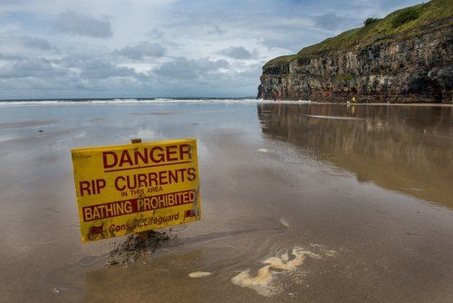Rip currents are responsible for more than 100 deaths per year in the United States, and lifeguards save thousands more. In fact, the United States Lifesaving Association estimates that rip currents account for 80% of lifeguard rescues per year at beaches that have breaking waves. Rip currents are powerful undercurrents that can travel up to 8 feet per second or more than 5 miles per hour. In contrast, the fastest swimmers can only travel about 5.4 feet per second or a little more than 3 ½ miles per hour.
While swimming near shore, people can become trapped in rip currents without realizing it. Generally, you won’t feel yourself moving until you look at a stable object, like the shoreline. Only then will you see that you are being pulled away from land at an alarming rate. Rip currents often form near beaches, reefs, sandbars, and piers, they can extend far out to sea.
On July 30, Zuzana Oravcova and Jevoney White drowned less than 80 miles apart. Both were victims of rip currents. Ms. Oravcova drowned near Point Pleasant Beach in New Jersey, and Mr. White drowned while swimming off of Smith Point Beach in Long Island, New York. This brings the death toll to 9 people who have died from rip currents in the month of June.
Here Are 2 Questions to Ask That Can Increase Your Safety:
1. What Do Rip Currents Look Like?
Spotting rip currents before starting your swim can help you avoid a life-threatening incident. In general, rip currents present a number of signs that alert cautious swimmers. Though difficult to spot, the warning signs are visible to a trained eye, and they can allow you to stay away from dangerous areas.
Signs of rip currents include:
- Discolored water from sand and sediment disrupted by the current
- A line of seaweed or debris moving away from the beach
- A gap in a line of waves, perpendicular to the beach
- A channel of unusually choppy water
The wind is an important factor that causes rip currents. However, even if it is not windy by the shore, a tropical storm far out to sea can also create rip currents. It is important to remember that the signs are not always clearly visible, and even if you don’t see any warnings, the ocean may still be unsafe. Furthermore, the National Weather Service issues advisories for each city, ranking the risk as low, moderate, and high. You can also pay attention to the flag warnings at each particular beach to understand the current risk level.
2. How Should I React If I’m Caught in a Rip Current?
The first thing to remember is: don’t fight it. Many people exhaust themselves quickly because they try to swim straight back to shore. However, rip currents are stronger than the world’s fastest swimmers, so avoid trying to swim against the current, and stay calm.
Instead of swimming against the current, swim parallel to the shore. Rip currents are often narrow, and you can try to swim out of it by going to the side. Once you break out of the current, you can swim at an angle back to shore, following the waves.
If you are caught in a rip current and being dragged out to sea, wave your hands and alert lifeguards and other people on shore. You should yell and make yourself as visible as possible. This will alert them to your situation and prompt an immediate rescue response. It is also a good idea to avoid swimming when no lifeguard is on duty. Even if you think you are a good swimmer, you may be caught in a powerful current and swept out to sea.
Many people have been killed trying to save other swimmers caught in rip currents. If you see someone in trouble, alert lifeguards immediately. Don’t try to save them yourself by swimming to them. Instead, you may be able to take a rescue boat, throw them a flotation device, and pull them to shore.
Dedicated to Your Safety & Right to Compensation
At Morici, Longo & Associates, we are passionate about guiding clients through the legal system. Our Chicago personal injury attorneys have represented hundreds of clients who have been injured by someone else’s negligence. If you have been involved in an accident, or a loved one has died because of a lifeguard’s negligence or lack of warning about rip currents, we can investigate the incident and aggressively fight for your case.
Contact our firm today for a free consultation. We also offer Spanish-speaking services for your convenience.

